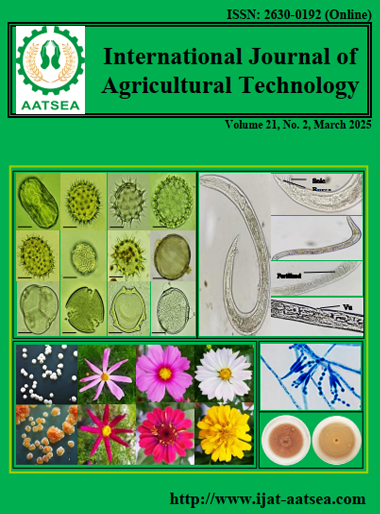Effects of LDD1 compost and chemical fertilizer on the growth, yield and antioxidant activity of Chrysanthemum indicum L.
Main Article Content
Abstract
Chrysanthemum, one of the most valuable crops and medicinal plants, is increasingly cultivated for its pharmacological benefits. The combination of LDD1 compost and chemical fertilizer showed the highest number of flowers, which was significantly greater than other treatments. Additionally, LDD1 compost alone resulted in the highest dry root weight. The antioxidant activity of bioactive compounds extracted from dried chrysanthemum flowers was evaluated by measuring total flavonoids, phenolics, and 2,2-diphenyl-1-picrylhydrazyl (DPPH) scavenging activity. Although the flavonoid and phenolic contents did not significantly differ among the treatments, fertilization led to significantly higher antioxidant activity compared to non-fertilized plants. The study highlighted the potential of using LDD1 compost, or a combination of LDD1 compost and chemical fertilizer at half the rate, to promote vigorous growth, high yields, and enhanced antioxidant activity. This approach helps to reduce the reliance on chemical fertilizers.
Article Details

This work is licensed under a Creative Commons Attribution-NonCommercial-NoDerivatives 4.0 International License.
References
Buakum, B. and Sanprasert, R. (2017). Comparison of growths and yields of Asiatic pennyworth (Centella asiatica (L.) Urb.) with chemical and organic fertilizers. Journal of Science and Technology, Ubon Ratchathani University, 19:101-110.
Ghanbari, J., Khajoei-Nejad, G., Van Ruth, S. M. and Aghighi, S. (2019). The possibility for improvement of flowering, corm properties, bioactive compounds, and antioxidant activity in saffron (Crocus sativus L.) by different nutritional regimes. Industrial Crops and Products, 135:301-310.
Gholami, H., Saharkhiz, M. J., Fard, F. R., Ghani, A. and Nadaf, F. (2018). Humic acid and vermicompost increased bioactive components, antioxidant activity and herb yield of Chicory (Cichorium intybus L.). Biocatalysis and Agricultural Biotechnology, 14:286-292.
Hamedi, B., Pirbalouti, A. G. and Rajabzadeh, F. (2022). Manures, vermicompost, and chemical fertilizer impacts on the yield and volatile compounds of the damask rose (Rosa damascena Mill.) flower petals. Industrial Crops and Products, 187:115470.
Land Development Department, Ministry of Agriculture and Cooperatives, Thailand. (2015). Land development manual for volunteer soil doctors and farmers. 242 p.
Leaungvutiviroj, C., Ruangphisarn, P. and Sangseeleung, J. (2007). Study on isolation and selection microorganisms to produce microbial activator Super LDD1. Research report, Land Development Department, Ministry of Agriculture and Cooperatives, Thailand.
Lee, K. D., Yang, M. S., Renseigné, N. and Smith, D. L. (2005). Fertilizer effect on the yield and terpene components from the flowerheads of Chrysanthemum boreale M. (Compositae). Agronomy for Sustainable Development, 25:205-211.
Liu, X., Ren, G. and Shi, Y. (2011). The effect of organic manure and chemical fertilizer on growth and development of Stevia rebaudiana Bertoni. Energy Procedia, 5:1200-1204.
Luyen, B. T., Tai, B. H., Thao, N. P., Lee, Y. M., Lee, S. H., Jang, H. D. and Kim, Y. H. (2015). The anti-osteoporosis and antioxidant activities of chemical constituents from Chrysanthemum indicum flowers. Phytotherapy Research, 29:540-548.
Office of Agricultural Research and Development Region 6. (2022). Report for soil and fertilizer sampling tests (in Thai). Department of Agriculture, Ministry of Agriculture and Cooperatives, Thailand, 2 p.
Prasanna, R., Kanchan, A., Kaur, S., Ramakrishnan, B., Ranjan, K., Singh, M. C., Hasan, M., Saxena, A. K. and Shivay, Y. S. (2016). Chrysanthemum growth gains from beneficial microbial interactions and fertility improvements in soil under protected cultivation. Horticultural Plant Journal, 2:229-239.
Poomipan, P., Anugoolprasert, O., Pliumchareorn, C. and Chomphuphiw, P. (2015). Comparison between chemical fertilizer and high quality organic fertilizer on yield quantity and quality of rice variety Suphan Buri 1. XIIth KU KPS National Conference, 2158 p.
Puttajunyawong, S. (2013). Effects of combined application of compost produced by microbial activator Super LDD1 and chemical fertilizers on potato yield in San Sai series. Land Development Department, Ministry of Agriculture and Cooperatives, Thailand.
Rattananoppanun, K. (2013). The study on effects of high-quality organic fertilizer formula 1 with compost from microbial activator Super LDD1 and Super LDD3 to reduce the use of chemicals in growing tomatoes. Research report, Land Development Department, Ministry of Agriculture and Cooperatives, Thailand.
Rawdkhao, T. (2020). Organic chrysanthemum production. The Office of Agricultural Research and Extension, Maejo University, 22 p.
Ruenwai, R. (2020). Analysis of phenolic content and free radical scavenging capacity of Chrysanthemum flower extracts. Naresuan Phayao Journal, 13:16-20.
Rungsirisakun, R., Boonyaritthongchai, P., Sampanvejsobha, S. and Mengveha, N. (2016). Integrated product and process development: chrysanthemum tea. Research report, King Mongkut’s University of Technology Thonburi.
Sharma, N., Kumar, M., Kumari, N., Puri, S., Rais, N., Natta, S., Dhumal, S., Navamaniraj, N., Chandran, D., Mohankumar, P. and Muthukumar, M. (2023). Phytochemicals, therapeutic benefits and applications of chrysanthemum flower: A review. Heliyon, 9.
Singleton, V. L. and Rossi, J. A. (1965). Colorimetry of total phenolics with phosphomolybdic-phosphotungstic acid reagents. American Journal of Enology and Viticulture, 16:144-158.
Taneja, T., Kumar, M., Sharma, I., Kumar, R., Sharma, A. and Singh, R. (2024). Composting of agro-phyto wastes: an overview on process, factors and applications for sustainability of environment and agriculture. Current World Environment, 19:1-10.
Thepsilvisut, O. (2017). Comparative study on effect of organic and chemical fertilizer on productivity of White mugwort. Thai Science and Technology Journal, 25:615-626.
Wen, Z., Shen, J., Blackwell, M., Li, H., Zhao, B. and Yuan, H. (2016). Combined applications of nitrogen and phosphorus fertilizers with manure increase maize yield and nutrient uptake via stimulating root growth in a long-term experiment. Pedosphere, 26:62-73.
Wu, L. Y., Gao, H. Z., Wang, X. L., Ye, J. H., Lu, J. L. and Liang, Y. R. (2010). Analysis of chemical composition of Chrysanthemum indicum flowers by GC/MS and HPLC. Journal of Medicinal Plants Research, 4:421-426.
Yang, C., Yang, L., Yang, Y. and Ouyang, Z. (2004). Rice root growth and nutrient uptake as influenced by organic manure in continuously and alternately flooded paddy soils. Agricultural Water Management, 70:67-81.
Zhishen, J., Mengcheng, T. and Jianming, W. (1999). The determination of flavonoid contents in mulberry and their scavenging effects on superoxide radicals. Food Chemistry, 64:555-559.
Zhu, K., Zhou, H. and Qian, H. (2006). Antioxidant and free radical-scavenging activities of wheat germ protein hydrolysates (WGPH) prepared with alcalase. Process Biochemistry, 41:1296-1302.


